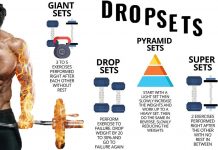💪HEAVY VS LIGHT WEIGHT TRAINING
✳️ Both training styles can help you achieve the goal of muscle hypertrophy, however, there are a few things to understand:

[wp_ad_camp_2]
Light load training (16-30 RM) can produce similar hypertrophic adaptation to heavy/moderate lifting (6-8 RM) only when performed to failure.
And this simply isn’t an efficient strategy, atleast not as efficient as using moderate/heavy loads when training. Why?
Because heavy training allows for these adaptations to occur in a much shorter time with less CNS fatigue build up.
First of all, muscular failure refers to a point during strength training at which we can no longer perform the lifting phase of an exercise through the required range of motion without altering our technique.
This point is determined by the ability of the muscle fibers to produce force, which is affected by the level and type of fatigue that they are experiencing: Peripheral Fatigue (within the muscle) and/or Central Fatigue (Nervous System).
[wp_ad_camp_1]

[wp_ad_camp_4]
If muscular failure is induced by peripheral fatigue, there’s an increase in motor unit recruitment: basically, as lower threshold motor unit muscle fibers fatigue, higher ones are activated. This is good: we can recruit the fibers that can grow after strength training.
If instead it’s caused (partly) by Central Fatigue, full motor unit recruitment is prevented from being reached: this means that if CNS fatigue is high, our ability to recruit higher threshold muscle fibers will be inhibited. So we won’t be able to stimulate them. Not good.
When lifting heavy loads, motor unit recruitment is high (and even greater) thanks of the heavy weight. We’re able to stimulate high threshold muscle fibers & get to “hypertrophic reps” much sooner.
[wp_ad_camp_3]
This means that, while training with light loads to failure can definitely reach similar adaptations to heavy load lifting (as long as we’re able to maximize Periph. over CNS Fatigue), the latter is simply more efficient at reaching the goal faster.
Therefore, while training to failure can be a great strategy to implement in a training program, it’s definitely unnecessary.

















































